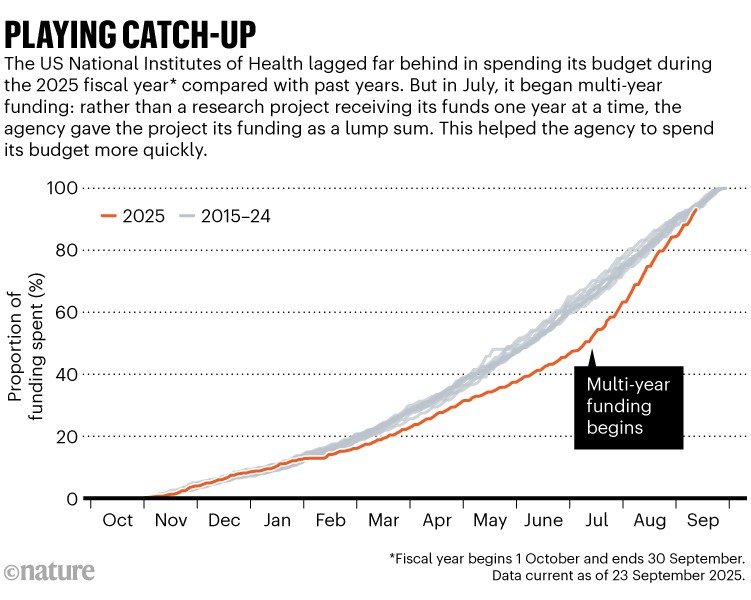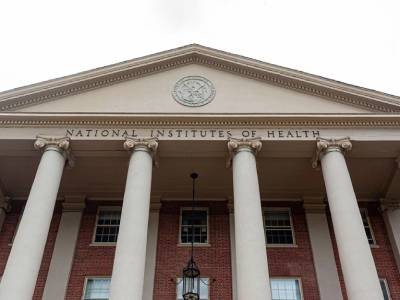The US National Institutes of Health fell as much as US$5 billion behind in its awarding of grants this past year, but has managed to catch up.Credit: Francis Chung/POLITICO/AP/Alamy
Staff members at the US National Institutes of Health (NIH) seem to have done the impossible. Despite US President Donald Trump’s administration laying off thousands of the agency’s workers, delaying meetings to review research grants and terminating funding for some projects, the NIH seems like it will dole out its entire US$48-billion budget on deadline — by the end of the fiscal year on 30 September.
At some points in the past year, the agency — the world’s largest funder of biomedical research — was nearly $5 billion behind in its awarding of grants. Researchers feared that the NIH would have to return any money it didn’t spend to the US Treasury rather than investing it in science. But staff banded together to put things on track in the past few months (see ‘Playing catch–up’).
“Everyone has been rallying together to clean up the mess, but it’s a mess that did not need to be made,” says an NIH programme officer who spoke to Nature on condition of anonymity out of fear of reprisal.

Source: NIH Reporter; adapted from: Jeremy Berg
Although the agency’s budget will be spent, many fewer new projects will be funded. That’s because the White House budget office directed the NIH to award some research projects large sums upfront — rather than spreading it out over years — meaning that fewer institutions and researchers will receive agency funding. Success rates for grant applications at the NIH have therefore hit all-time lows.
“That is extremely demoralizing,” says Michael Lauer, who, for about ten years ran the NIH’s ‘extramural’ arm, which funds researchers at institutions across the United States. “We want people to be excited about being in science. And if the likelihood of success is so low, you might have to close your lab, this will do even more to chase people away from doing science in the US.”
The NIH did not respond to Nature’s queries about the funding situation or scientists’ concerns about low success rates.
An ‘unbelievable’ year
Since Trump took office in January, his administration has directed the NIH to suspend sessions to review grant applications, lay off about 6% of its 20,000-person workforce, terminate projects on a slew of topics such as COVID-19 that do not align with the president’s priorities and freeze and unfreeze its funding programmes several times. Furthermore, representatives of billionaire Elon Musk’s Department of Government Efficiency demanded that they review grants approved by NIH employees before any payments were made, Nature reported.

Exclusive: NIH to dismiss dozens of grant reviewers to align with Trump priorities
“This year was really unbelievable,” says an NIH grants-management specialist, who has been at the agency for a decade and requested anonymity out of fear of retaliation. “I have never experienced anything like this.”
The administration’s spending slow-down at the NIH earned a reprimand in early August from a watchdog agency in the US government. The watchdog found that the NIH had been illegally withholding, or impounding, funds that the US Congress allocated to it.
To pick up the grant-processing pace, some employees have cancelled holiday plans, worked overtime and filled in for staff missing across the NIH, the programme officer says. “Our work is already end-loaded towards the end of the fiscal year,” she says. But this year, “it’s like a pressure cooker that exploded”. But, she adds, “there was a willingness to work extra hard to move the science forward”.